articles & guides
What is digital transformation and how to use it for the benefit of your business
In a nutshell
An inevitable process of change that, when applied to a company’s vital processes, can have a disruptive effect. This is Digital Transformation, and here you’ll find key technologies and new application models of the data-driven world to implement in your organization.


Don’t have time to read it all?
Here’s a brief summary of the key points in this guide.
What is exactly Digital Transformation?
Digital transformation is the use of integrated technology enablers in complex people-driven organizations, with the goal of introducing new business models, maximizing growth opportunities, and/or increasing efficiency and productivity. This is my personal definition of digital transformation. It includes everything that impacts on business models, processes, technologies, and skills of human beings.
[DIVE IN]
What technologies should I introduce in my company?
Technology plays a leading role in digital transformation as it supports the digitalization of organizations. It should be considered, however, that there is no single IT application that alone is capable of governing change: there is a multiplicity of key processes that a company must introduce step by step to manage innovation. Let us see, below, some key technologies:
- • Big Data
- • Network dynamics
- • Cloud Computing
- • Modern ERP technologies and databases
- • AI and machine learning solutions
- • Advanced analytics
- • Internet of Things
- • Robots and Robotic Process Automation (RPA)
[DIVE IN]
Who is the CDO and what do they do?
Chief Digital Officers occupy a strategic role in digital transformation. They must be innovation accelerators, because their job is not only to innovate correctly, but to get ahead of the competition. Therefore, CDOs should:
- • Be multi-channel strategists
- • Take up new challenges
- • Manage employee relationship
- • Have strong expertise in sales
- • Have curiosity toward new tools
- • Have authority and engagement skills
- • Have KPIs definition skills
- • Have leadership
- • Know the target industry
- • Show a multi-disciplinary approach
- • Focus on customer experience and usability
- • Share digital marketing insights
[DIVE IN]
Yeah, but why should I welcome Digital Transformation in my company?
Simply, digital transformation is no longer an option. Ignoring an obvious need can have fatal consequences: demand for some business sectors will decline or disappear altogether. If you want to remain competitive, you must react to change and challenge current business structures. Digital transformation:
- • Offers new customer experiences
- • Generates new sources of revenue
- • Improves operational efficiency
- • Creates a competitive advantage
- • Improves internal collaboration
- • Promotes a culture of innovation
- • Enables quick reaction to market changes
[DIVE IN]
LEARN TO RIDE
Ready to surf the digital wave and become a leader in your industry? Join Execute.Club, where executives and managers like you can access resources, connect with peers, and get the no-nonsense help you need to succeed in the digital era.
Enter the ClubIntroduction
Digital transformation is a key component of a broader business revolution strategy of reorienting a company toward the application and use of emerging technologies. It is a necessary rethinking of business models and customer experience, aimed at identifying new ways to deliver value, generate revenue, and improve efficiency.
Living the fourth industrial revolution
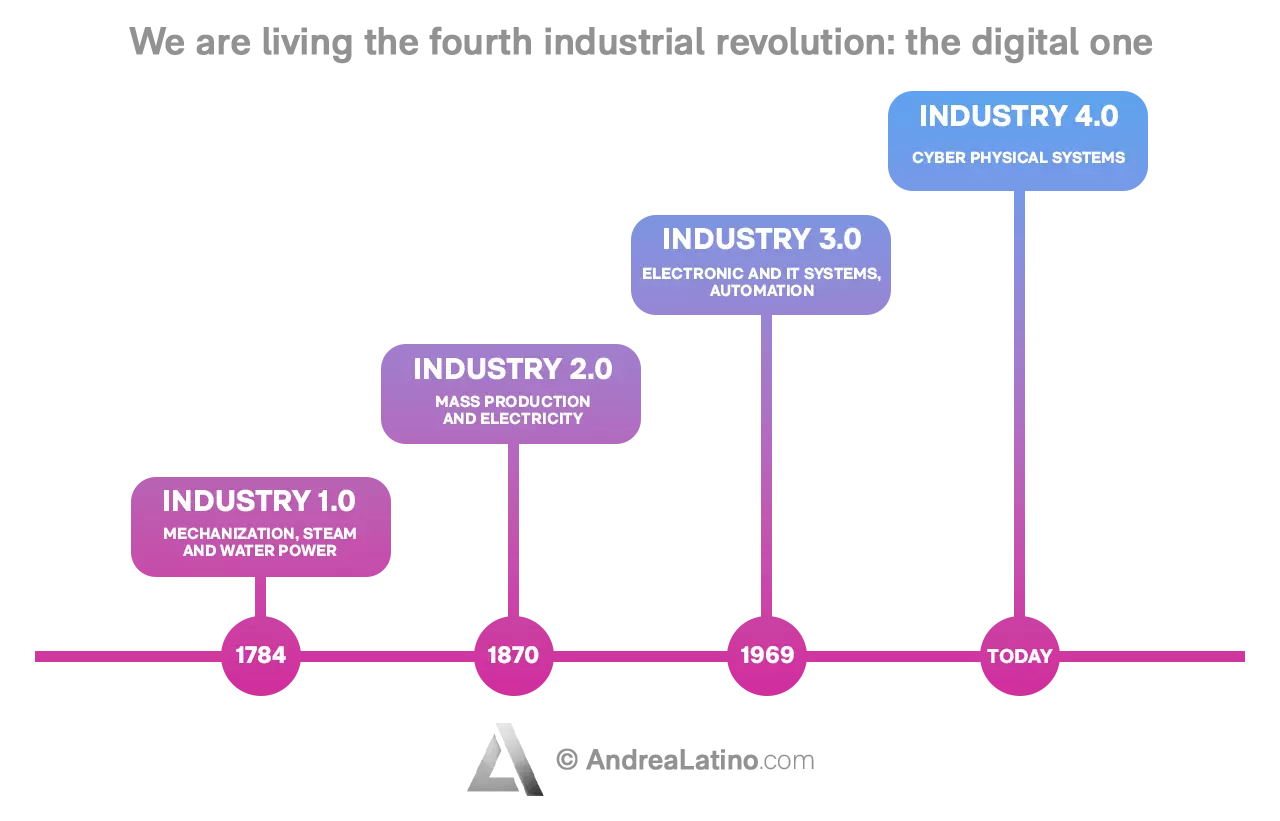
Today’s businesses face fierce competition and rapidly increasing customer demands. Speed has become the new currency of business: companies must meet the expectations and needs of employees and consumers as quickly as possible. Organizational, production and business dynamics have changed and customers are becoming more and more connected, informed, interactive. They want to be able to trust the brand. Workers and companies therefore need cultural and technological change.
It is the fourth industrial revolution: the digital one. New technologies such as artificial intelligence, the Internet of Things and machine learning have reinvented the way we work, buy and relate to one another. Digital transformation is no longer an option. Companies must develop a plan to identify with the new scenario and avoid obsolescence. If used well, technology offers enormous potential to generate new business opportunities and open new markets.
What is digital transformation?
Digital transformation is the use of integrated technology enablers in complex people-driven organizations, with the goal of introducing new business models, maximizing growth opportunities, and/or increasing efficiency and productivity. This is my personal definition of digital transformation. It includes everything that impacts on business models, processes, technologies, and skills of human beings.
It is no coincidence that the term “transformation” is used: the expected change is not a one-time event, but a constant state of transition to digital that involves society and the economy as a whole, and more specifically businesses. The latter will gradually encompass and take advantage of the opportunities offered by new technologies to change processes and structures and remain competitive.
In short, digital transformation is critical to the success or failure of any renewal effort. Industries must come to terms with new digital capabilities and use them sensibly to maintain an edge over competitors in an ever-changing business environment. These are electronic, scientific, data-driven, quantified and most likely automated capabilities.
Key elements of digital transformation
First of all, it is important to note how, in turn, digital transformation can also affect digital strategy, as they are linked. But digital strategy is related to marketing, sales, and everything that is front-end with respect to the end consumer. The goal is to boost growth and revenue. Digital transformation focuses on enablers, processes and technologies.
Hence, key elements of digital transformation are:

However, it is important to clarify that when we talk about enabling technologies, it is not simply a matter of taking and grafting a single new technology component (software). It is about setting up multiple software platforms integrated with each other. Otherwise it wouldn’t be digital transformation but another type of process called system integration.
DOWNLOADABLE FILES
- Digital Transformation Canvas – Download now!
Thus, it is critical that all three elements are aligned. I’ve just explained what would happen if there were only enabling technologies, but multiple other cases can occur. For example, people without software wouldn’t be able to perform any digital transformation: things would remain in their current state. Or, again, if you have the right business models but you lack people and technology, you won’t be able to ground them. And, vice versa, if you can rely on digital and human beings but you don’t have a business model, you’ll realize you have no specific vision and you won’t know which way to go.
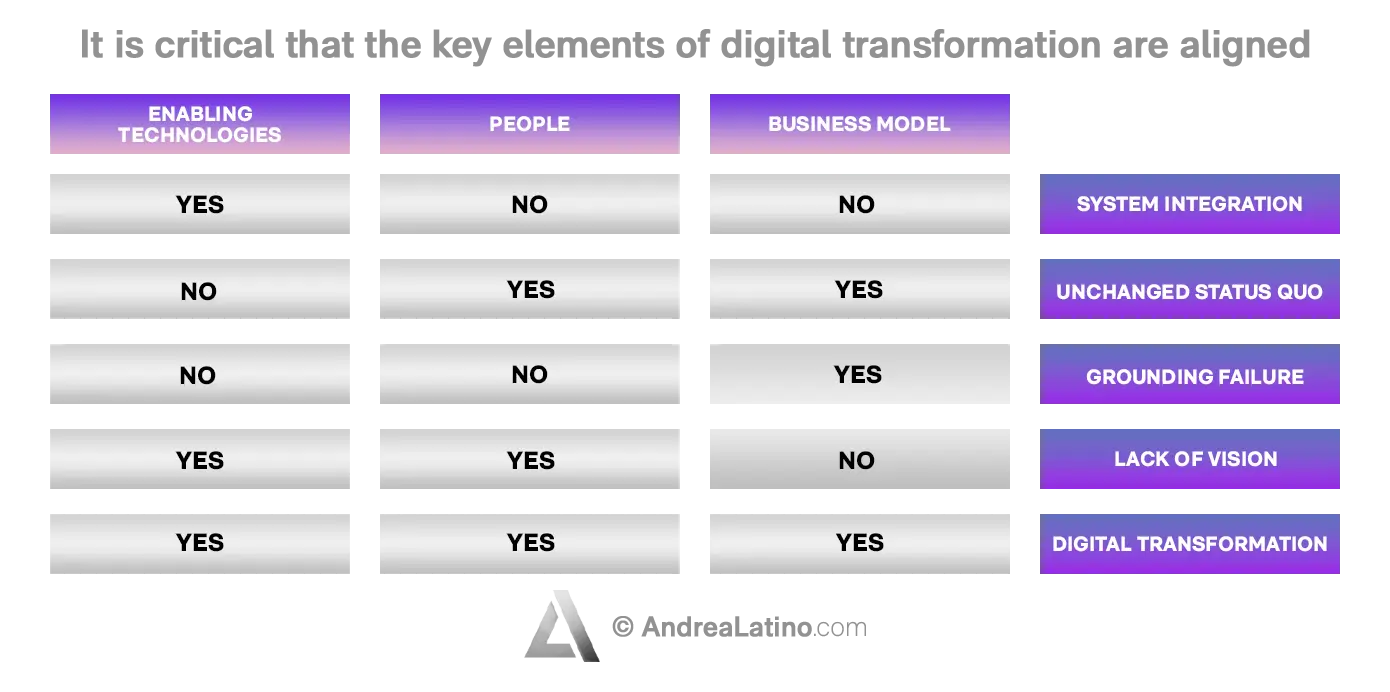
But is it just a technological change?
Absolutely not. A key aspect of digital transformation, without which the desired results would not be achieved, is the cultural change it brings. This process does not mean simply investing in the latest technology and applying it to departments. Technology alone does nothing. Transformation emphasizes the need to redefine processes and mindsets to generate permanent digital change.
The right technologies, applied by the right people, enable organizations to respond quickly to snags and opportunities, meet new (increasingly ephemeral) customer needs, and drive growth toward future innovations. Digital transformation permeates the experience of daily life, constantly challenges the status quo, encourages experimentation, and enables people to feel comfortable with failure.
Finally, do not think that moving to a digital orientation represents some kind of “shortcut” that merely shortens some steps. Digital transformation is more than simply compressing a process into a set of data. When an organization takes steps along the digitalization path (gradually, according to its capabilities and needs), it produces a change in its business model because processes and data are interconnected.
digital applied to business
How to do digital transformation in business
Digital transformation, we said, involves the overall rethinking of a company, from processes to the cultural horizon. It must completely adapt the company to the functioning of the contemporary world and make it faster and more reliable on short-term goals. Technology, the characteristics of the new worker and new organizational systems are the factors that enable companies to survive in an unpredictable and increasingly competitive environment.
A change that should start with the educational model: betting on adaptive skill development based on the type of intelligence of the student, focusing on the training of key skills such as entrepreneurship, critical and computational thinking, integrating this with technology to give added value. After all, organizational transformation itself is best achieved through collaboration and open discussions.
The magic word for digital transformation is flexibility: digitalization must not be driven by a rigid system, but by linking interfaces, reducing bureaucracy, and constant development. A company that wants to grow and compete must be resilient, responsive, and proactive. It must stay up-to-date and observe new trends in society, new customer desires. Collect data, create analysis, get the knowledge they need.
An effective and profitable digital transformation
Now listen closely: digital transformation must affect every department and every level of the company, from the individual employee to the board of directors. Processes, services, methods, resources, machines, and people. Everything that falls within the corporate universe. The digital landscape must be developed and improved starting from the very first steps in the supply chain, to meet the changing demands of customers, offer them personalized service and innovate traditional business models.
Indeed, nowadays, the first question to ask is: how can we satisfy our customers’ desires better and faster? The change brought about by digital transformation is the answer, as it offers consumers exactly the kind of relevant, timely and tailored experiences they want. Organizations are now listening to buyers and creating the products they want, rather than forcing them to buy products created in advance. And useful information in this regard is provided to engineers, designers, and manufacturers by one of the cornerstones of digital transformation: data.
Digital transformation: technologies you should introduce
Technology therefore plays a leading role in digital transformation as it supports the digitalization of organizations. It should be considered, however, that there is no single IT application that alone is capable of governing change: there is a multiplicity of key processes that a company must introduce step by step to manage innovation. Based on data, new technologies help identify customer needs, desires, and fears, devise new offerings, and deliver individual services quickly and specifically.
Let us see, below, some key technologies:
Big Data
Keep them in mind, because they will return often. In the digitalized and interconnected world, users leave behind a lot of information that companies can use to their advantage. Data acquisition and analysis are very important aspects of a company’s success. By properly assessing existing data (and optimizing data collection), customer needs can be filtered and, as a result, the company’s goals and strategies can be aligned. Even the success of a marketing or sales initiative can be measured by the data generated.
I mean, the overwhelming digital transformation of industries would not be possible without data: it helps uncover new opportunities and predict trends (from consumer spending patterns to macroeconomic trends) to move ahead in emerging markets. It is the true enabler of new technologies and solutions, the place from which important and actionable business information is derived. Knowing how to recognize and leverage quality data is the critical differentiator that drives digital transformation.
Network dynamics
This is closely related to the training, collection, and study of Big Data (as, after all, is every technology we will go into later). People all over the world are connected within a digital community and are exchanging information on social networks.
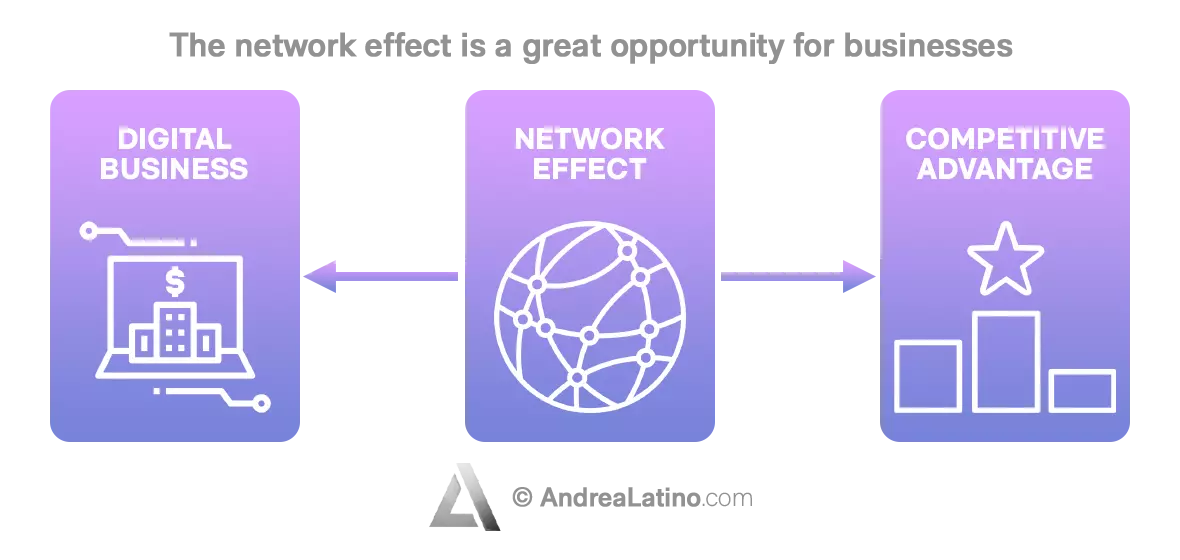
An opportunity not to be missed for companies: communicate with their customers in the most direct way possible and offer them a platform for interaction. The network effect should not be underestimated. On social networks, existing members benefit from the arrival of new participants, as a very interesting specific dynamic is developed.
Cloud Computing
Cloud-based infrastructure is another essential component of a complete digital transformation. Centralized on-demand access to data, systems, and resources enables organizations to quickly reach needed software, new features and updates, and data storage. It is a solution that gives agility, and is functional for transforming, modifying, and automating workflows.
Modern ERP technologies and databases
Enterprise Resource Planning is a management software that includes all relevant business processes of an enterprise and all business functions. In fact, it is the brain that guides and maneuvers the digital transformation of the company using in-memory database technology.

ERP collects information from every department or process (finance, human resources, manufacturing, supply chain, etc.) and integrates it into a single system. If it is then powered by AI technologies, not only does it manage and process Big Data, but it also analyzes and learns from it.
AI and machine learning solutions
Big Data, after all, goes hand in hand with artificial intelligence and machine learning, without which it would not be possible to process data and make sense out of it. But for the results obtained to be accurate and meaningful, AI and machine learning must have datasets large enough to support robust learning and analysis.
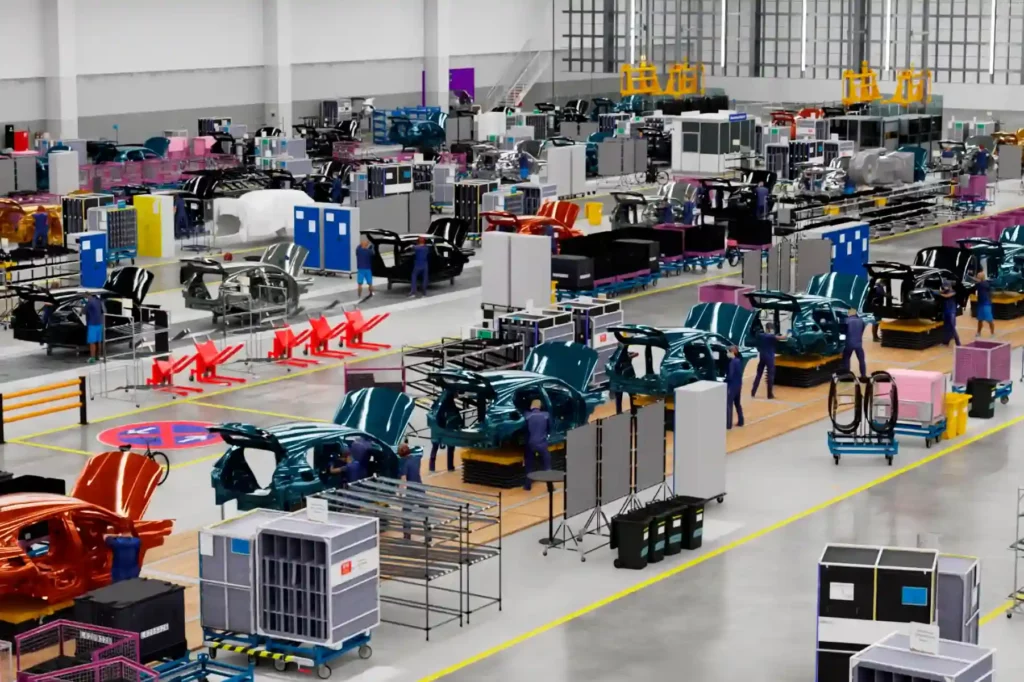
They are expensive and sophisticated but revolutionary solutions capable of driving predictive planning and responsive automation. They then provide useful information to make accurate decisions in sales, marketing, product development and many other strategic areas.
Advanced analytics
Artificial intelligence and machine learning algorithms enable the true value of data to be derived. Advanced analytics provide insights, accurate and actionable reports. What’s more, business leaders can take the initiative by requiring customization of data analysis configurations.
Internet of Things
An IoT network consists of devices capable of “communicating” with each other (sending and receiving digital data). Machines send maintenance reports that can help optimize performance and efficiency.
Business systems of this type leverage AI to analyze the information collected and detect patterns, trends, and correlations. Needless to say, as machine learning applications “learn” from IoT data, productivity gains follow.
Robots and Robotic Process Automation (RPA)
Automated processes that take charge of repetitive or preprogrammed tasks. What else do you want? These anthropomorphic robotic machines have moving mechanical parts charged which perform specific physical tasks. RPA processes are similarly programmed but exist only as software and perform administrative tasks.
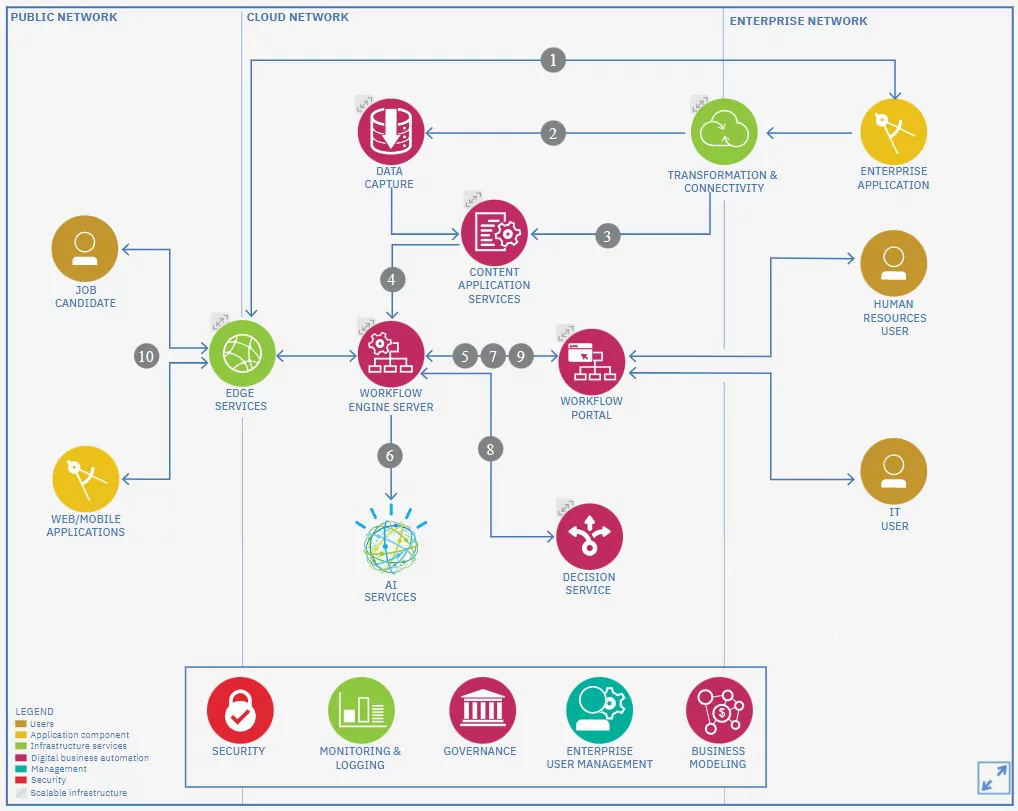
New Models
Digital transformation and its changes
Digital transformation is a revolutionary process. As we have seen, it is not only about introducing the latest technologies but even requires a profound paradigm shift in thinking. Integrating digital solutions into every area of a company, then, is as much a technological change as a cultural one because it requires organizations to resolutely intervene in the way they operate and in the way they deliver experiences and benefits to customers.
Modern companies, after all, have to dynamically restructure existing ideas and adapt corresponding processes and strategies accordingly. And it is not simply – I think it is now clear – a matter of buying more powerful computers or storing data in the cloud. Digital transformation requires a change first and foremost in the mindset of managers, and from them in the attitude of employees.
So, to recap: the changes to be adopted must start with people. People, in turn, must accept the change, shift their mindsets, get out of the comfort zone. And the best way to help them is to provide them with the right tools to develop the digital skills (“soft skills”) they need. Digital transformation is a commitment to the future, to new ways of working that harness the full potential offered by technology.
Which models will be transformed?
New technologies certainly play a central role as drivers of transformation, but they are not the only players. Organizational culture, receptivity to change, business processes and business models also have a voice.
Hence, digital transformation reinvents almost every aspect of a company: the supply chain, workflows, employee skills, discussions within the board of directors, interactions with customers, and the value assigned to them by stakeholders.
Business process transformation
It involves changing and readjusting core processes and workflows that have often been entrenched and consolidated for decades. The purpose is to meet changing business goals, outperform competitors and meet customer demands.

Once again, I need to emphasize how – despite the fact that the terms are often used interchangeably – digital transformation is a fundamental subcategory of the broader business transformation: it is the interconnected technological framework that supports change.
Business model transformation
It aims at the main procedures that constitute the way value is delivered in specific industries. In essence, companies that adopt digital transformation agree to change their traditional business models hoping to gain a competitive advantage.
A couple of examples: from a more general point of view, one kind of business model that leverages digital technologies is hub-and-spoke. It allows a company to set up local production sites that function as decentralized mini-factories located close to customers. And this enables the exploitation of local resources and thus greater alignment both culturally and legislatively with clients to ensure they receive the best possible service.
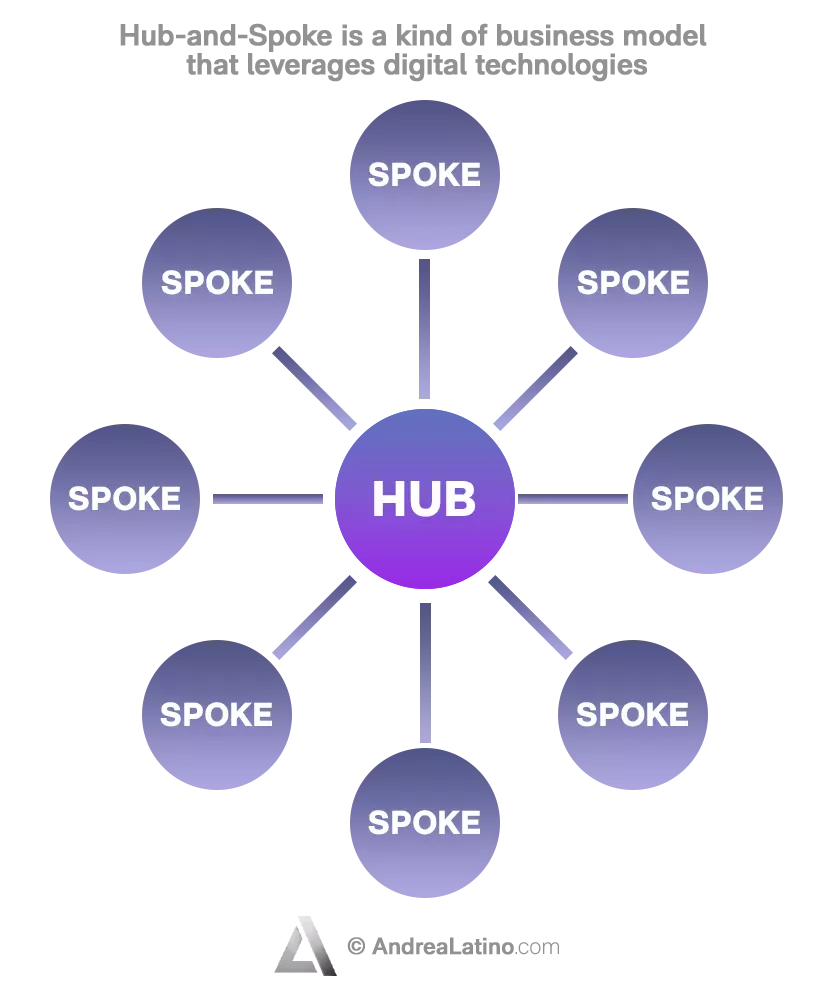
Going down further, one model for companies aspiring to digitally transform could be Apple – an emblematic model of vertical integration. Indeed, the company has traditionally thrived from selling physical devices running Apple’s proprietary operating systems. Its competing device makers, meanwhile, have had to rely on an operating system they could only license (mainly Windows for PCs and Android mobile).
Organizational transformation
A successful digital transformation does not overlook the importance of organization. If new technologies are adopted in a slow and messy manner, there is a risk of not achieving goals and suffering a loss of competitiveness, revenue, and brand value.
Therefore, a quick departure from classical organizational models in favor of liquid organizational models by introducing agile methodologies and systems becomes necessary.
Cultural transformation
Finally, as already pointed out, a complete digitalization cannot go without a renewed cultural alignment. Loss of trust in corporate values can affect the productivity, resourcefulness, and wellbeing of the workforce. The adoption of flexible work models could be an example of an initiative to foster internal cohesion.
It is best to specify that senior management must be deeply involved in the transformation project (not just employees). It must create a team of opinion leaders and internal sponsors to help build esteem and confidence during the transformation process and function as reference points.
Different approaches to digital transformation
Given the breadth of the scope covered, it is unimaginable that digital transformation could happen in the same way, at the same pace and according to the same procedures for every company in every industry. Usually, there are two main approaches to digital transformation, which lead to potentially different results.
The constellation approach
The first one is the constellation approach. Let’s take a large company: as such it will follow a number of internal projects. Each of them is an isolated digitalization project developing on its own. At the end of the transformation process, some projects will have been successful, others won’t. However, the silo effect will inevitably arise, since no project shares data or platforms with the others. Anyway, this is not a negative approach, because in any case it helps to push forward the digital transformation process.
It is a bottom-up approach in which you do not have the opportunity to build core elements because, for example, you can’t rely on Executive Buy-In. That means, executives pay lip service to the fact that they want to digitally transform the company, but they don’t know how, they can’t set up a top-down plan, or it is too expensive for them to invest in the basic infrastructure that is needed to implement the necessary solutions.
The backbone approach
The constellation approach is often embraced not because it is more efficient (although sometimes it can be successful), but under the guise of not knowing how to do it or not wanting to put in the money to do the “hard things”. These would be the backbone approach, a unified database or a data mining tool for trends. In other words, enablers—backbones, precisely—from which to start and build on top of them.
But a backbone approach requires a Chief Digital Officer or at least an aligned, trained management that does not totally delegate digital transformation processes into the hands of others. A management clearly establishing its priorities in building data fundamentals. This means making databases available in an interoperable way so that applications can then be linked together. And a culture of interaction with outside technology vendors.
Do you have a Strategy & Innovation challenge to tackle? Let’s face it. Together.
C-levels from these companies (AND MORE) relied on my expertise to overcome thEIR CHALLENGES IN THIS AREA. And you can, too.
Can I help you?Chief Digital officer
Who is the CDO and what do they do?
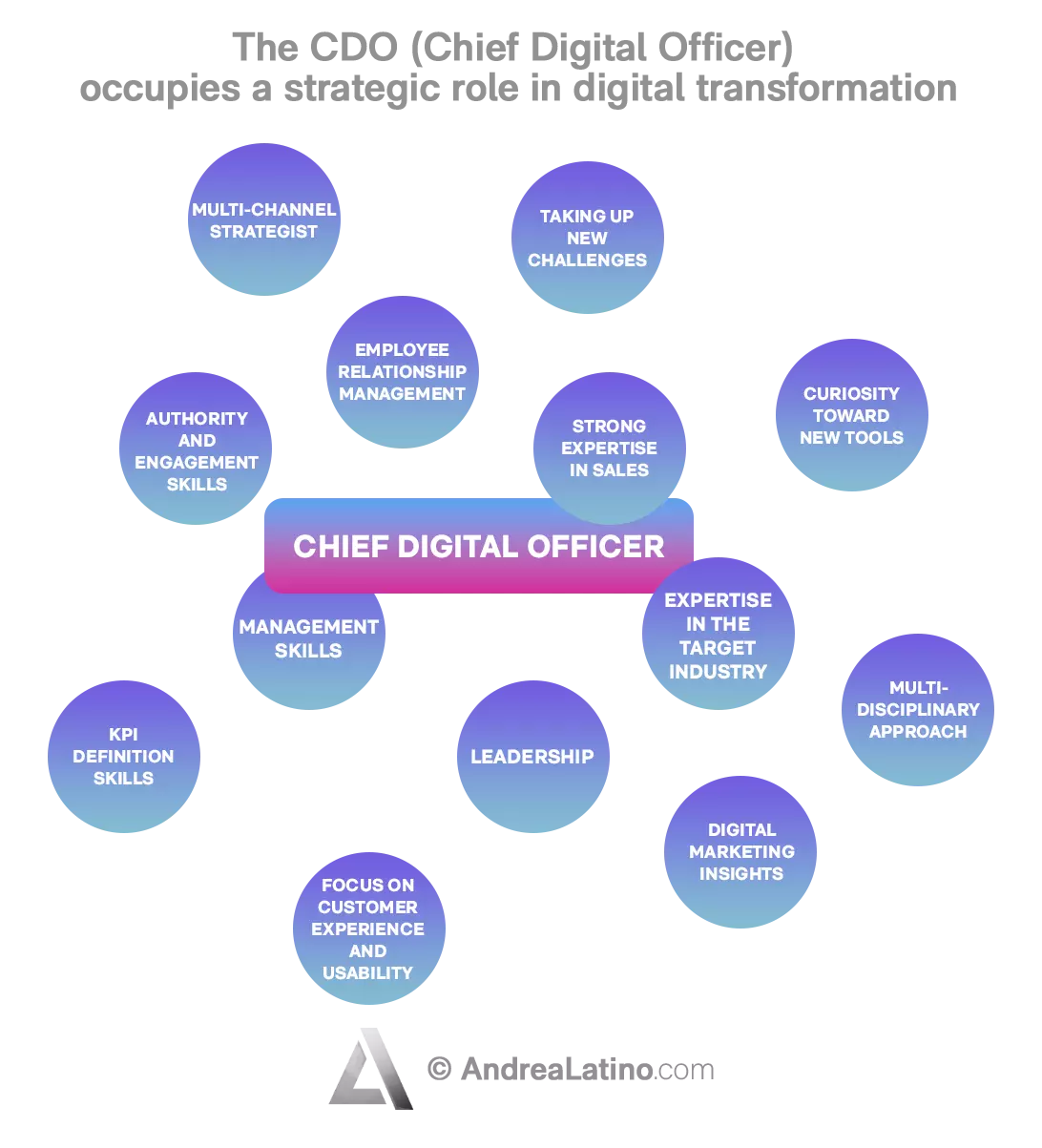
Digital transformation is not a purchasable product or solution. It is an ongoing process that seeks competitive advantage through new technologies and new ways of working. All job profiles in a company will need to experience change, but not everyone is equally prominent in the application of the technological revolution. The CDO (Chief Digital Officer) occupies a strategic role in digital transformation.
The CDO is a key figure in transformational initiatives, regardless of the industry or size of the company they work for. A hybrid, cross-cutting profile that has both IT and business skills. Chief Digital Officers must be able to ensure that the organization can adapt to emerging markets, grow, and transform uniformly. His greatest responsibility lies in leading the company through transformation and make it adopt the right tools and best processes to increase efficiency and optimize business strategies.
These are not just digital experts, but rather managers with many years of experience in their field, awareness of the business model, strong multidisciplinary and leadership skills, and a solid background in project management, customer service, ICT, HR, marketing, and sales, who can guide the company through digital transformation, planning its goals, tools, and timelines.
Why you should hire a Chief Digital Officer to digitalize your company
In the early days of digital transformation, the first companies to introduce this managerial figure were the most visionary and digital-oriented, but now that the process is already in place, no industry is excluded and every one can benefit.
A good CDO does not impose the use of certain tools abruptly. On the contrary, he or she first seeks to learn about and analyze the work teams’ habits and processes. To carry out this process, the CDO must first succeed in team building and motivating employees.
Only when the internal cultural process is universally embraced will it be possible to address external change. After all, the CDO is by definition a professional who collaborates with all business units of a company to create a system that innovates the already existing one.
Chief Digital Officer as a leader
It was the development of the new digital economy that promoted the figure of CDO in the company. A figure that today occupies a privileged space, being the contact between business strategies and the digital architecture available. They are true leaders, with some weight in the company’s strategic decisions.
Chief Digital Officers must be “long-term visionaries”, who understand how employees work and customers act and then apply their knowledge to transformation and foster competitive advantage. They must have strategic vision, promote the use of the most efficient channels for the customer, and holistically understand the industry in which their organization operates.
They must be innovation accelerators, because their job is not only to innovate correctly, but to get ahead of the competition. Finally, CDOs must explain to employees how information technology will bring value to the company and motivate them so that they are inclined to adopt and use new platforms or software programs.
In short, the CDO is an essential reference for understanding, identifying, and assessing the impact of changes. In order to align technology implementation with the company’s IT strategy, there can be no shortage of collaboration between departments. Thus, we could say that the CDO is in the right place at the right time to drive business digital transformation.
reasons, benefits, consequences
Digital transformation is no longer an option
Digital change occupies a significant role in business: the focus on customer desires and behavior is an increasingly central topic and, as a result, it influences transformation. Consumers want personalized and relevant products. It is the production system that must adapt, no longer the other way around. And this calls into play machines and processes, but also managers, workers, resources and services.
Thus, it seems to be understood that the drivers of change are precisely the pressing demands and expectations of customers who are already familiar with new technologies and wish to make their daily lives more and more convenient. Then, of course, the influence of digital innovations themselves, new competitive market conditions and changing regulatory requirements should not be underestimated.
Ultimately, today’s companies no longer need to ask whether they need digitalization to stay afloat (the answer is a given), but how soon they can begin the transformation journey. Ignoring an obvious need can have fatal consequences: demand for some business sectors will decline or disappear altogether. If you want to remain competitive, react to change and challenge current business structures.
The benefits of digital transformation

Digital transformation is sweeping through society, so it is also crucial for companies. Customers read optimized and tailored offerings into it, and companies derive from it an optimal adaptation of products and services to the target audience and the refinement of internal processes.
Technology automates repetitive tasks by turning them into software and converts processes into data. Data gives new importance to the customer experience. The ability to properly analyze data makes the company more efficient and more flexible.
The data optimize resource utilization by providing useful information about equipment (temperature, pressure, electricity, workload…) over time. It also helps manufacturers predict demand and plan critical maintenance procedures consequently.
The market is increasingly fierce: companies cannot afford inefficiencies that cost time and money. Digital transformation, supported by data, enables organizations to improve their operations – and particularly those with high-value assets.
The key is to see digitalization as an opportunity to combine new ways and practices that result in new techniques and skills. To summarize, digital transformation:
- • offers new customer experiences
- • generates new sources of revenue
- • improves operational efficiency
- • creates a competitive advantage
- • improves internal collaboration
- • promotes a culture of innovation
- • enables quick reaction to market changes
A data-driven world
Digital transformation is based on the dominance of Big Data, which can provide organizations with a complete overview of customer, employee, and end-user expectations. This means being able to manage the distribution of value, quality, and timing with full control, always providing the desired outcome.
Data then enables the delivery of a complete, timely, and satisfying user experience. Customer experience does not come from the speed with which the company answers the phone, but from the speed with which the customer can complete an order without needing multiple conversations. And the same expectations about experience apply to employees.
Companies have built the employee experience through human resources services such as payroll, benefits, and recruiting. But as the work experience becomes digital and automated, data focus on the actual experience, showing the current needs and feelings of the employee rather than the initiatives offered by the company.
Therefore, data allows us to reconsider many old assumptions. Think of Airbnb: the use of digital information made the company realize that it did not need to own physical assets (hotels and apartments). Values and opportunities can emerge with a new face from the digital reassessment of processes.
Some potential impacts of the digital transformation
Improved efficiency and productivity
Devices connected by the IoT network continuously transmit data, logs, and performance reports. When combined with the application of advanced analytics, they can facilitate predictive maintenance, reduce downtime, and provide detailed information for workflows.
Improved customer experience
Nowadays, customers want their needs to be met on their terms. Thus, personalization, omnichannel access and real-time data availability come into play to attempt to meet expectations, increase leads and promote loyalty.
Sound and competitive business growth strategy
Digitalization and interconnection involve new ways of collaborating to simplify future growth strategies, including developing innovative products and services, improving profitability and revenue channels, and seducing novel potential customers.
Business model innovation
The shifting demands of consumers and the market in general have highlighted business model innovation as a way to create value. But this inevitably requires the ability to collect and analyze real-time data and develop automated and intelligent processes.
Agility and resistance to interruptions
Modern companies also welcome digital transformation to equip themselves with tools for predictive analytics, with the aim of predicting possible disruptions, anticipating changes and market opportunities. The Covid-19 pandemic itself shed light on the vulnerabilities that still exist in many business processes and models.
A few examples
Digital transformation: some examples of involved industries
The digitalization of sales channels or digital transformation itself is a response to changing customer preferences. Just think of how the widespread use of smartphones and the increased speed of the Internet have changed the way consumers buy products and use services. Companies have responded by transforming sales channels and adding e-commerce sites and mobile apps to their traditional channels (usually physical stores).
But the examples do not end here.
Automotive industry
The automotive industry was among the early adopters of manufacturing robotics and digital automation, as well as subscription-based billing processes. As one of the most competitive industries in the world, innovations often focus on customer service and loyalty through personalization initiatives and a driver interface that provide safety and driver enjoyment, along with providing valuable data for product development and marketing.
Tesla made all their electric vehicle patents available for free. The choice was made for two reasons: to accelerate the market and to make their technology the standard. Then, pioneering companies in the industry like Ford, BMW and Toyota followed Tesla’s example.

Human Resources
Digital technologies have also driven change in the workplace through the introduction of Virtual Reality, chatbots, and mobile devices that personalize the onboarding process and improve employee support. The use of blockchain, then, ensures privacy and accuracy of information; machine learning eliminates bias and ensures support for diversity and inclusion.
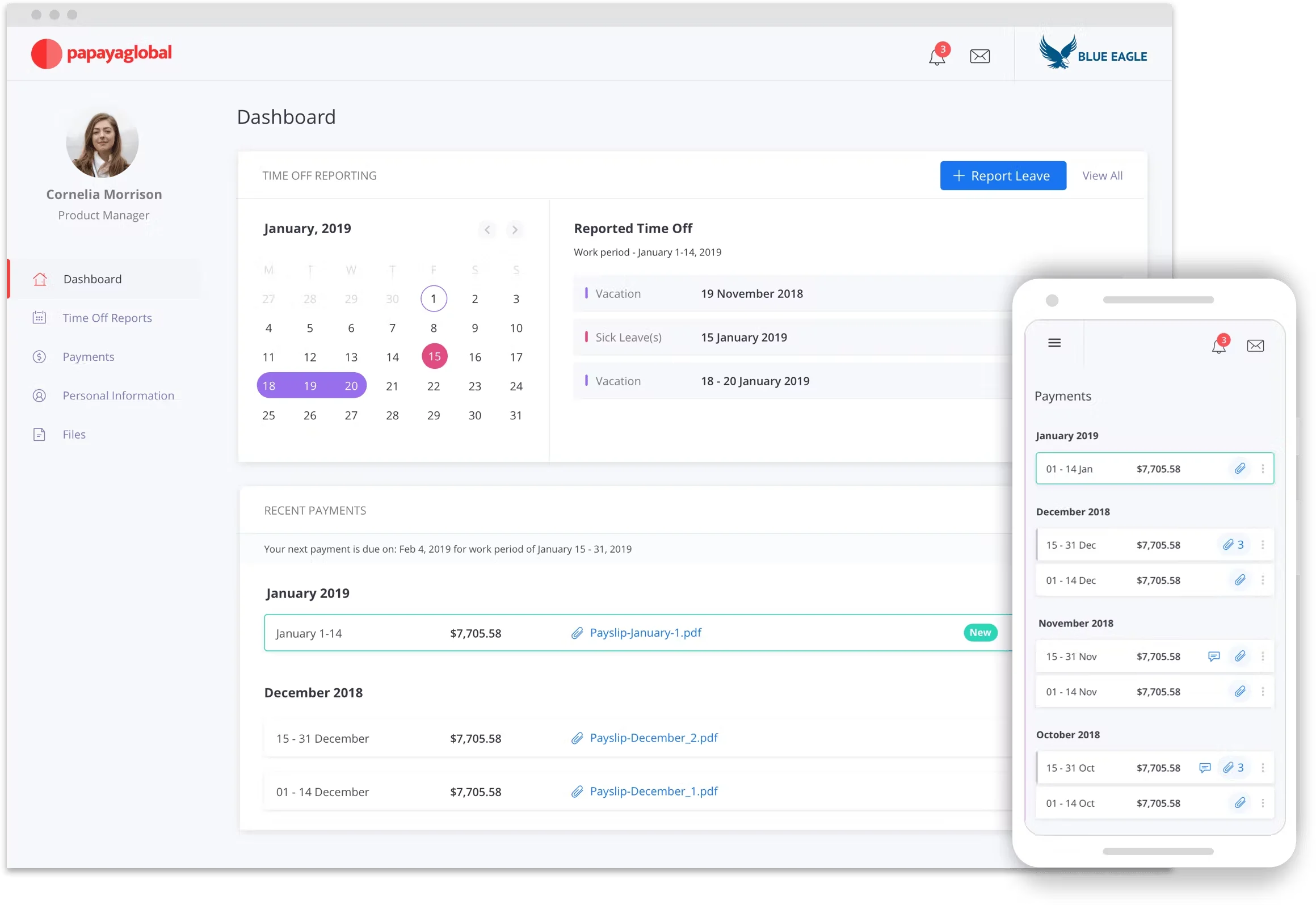
Healthcare
Research and diagnostic programs today rely on artificial intelligence and machine learning. The speed and accuracy of powerful databases and cloud technologies are indispensable for the most sophisticated surgical and medical devices. The assistance given by healthcare providers increasingly aims for improved monitoring options to ensure a feeling of safety in patients.
For example, Jurong Health Services, one of Singapore’s six healthcare clusters, recently underwent the Project OneCare initiative. It took four years, but the hospital integrated more than 50 healthcare IT systems and became paperless, scriptless, chartless, and filmless. IT enabled JurongHealth to achieve its mission of providing world-class medical care at an affordable cost.
Banking industry
Paper digitalization and process optimization are now standard for more efficient operations. Banks using digital formulas are seeing strong increases in adoption and satisfaction. Digitalized financial services enable wide customization possibilities, better mobile capabilities, and free remote access. And beyond that, even more complex services such as financial planning and credit management.
An iconic example comes from NatWest, which until July 2020 was known as Royal Bank of Scotland (RBS). As a centuries-old financial institution with over 70,000 employees and 700 banking locations, change needed to happen incrementally. In order to standardize and simplify processes and toolset, RBS adopted Lean-Agile solutions to open up transparency across all teams and correctly identify dependencies across the company. So, RBS went from 400 to 25 business cases per year. Their start-up processes thus simplified—they now take less than 12 days instead of eight weeks.
Retail
We are talking about automating and refining logistics networks, making delivery faster and more personalized. After all, Epsilon has recorded that 80 percent of shoppers are more likely to choose a retailer that offers personalized services (including chatbots active all day every day, tailored suggestions, and predictive recommendations).
IKEA may have found a way to decrease product returns. The home furnishings giant leveraged augmented reality to let customers see what the furniture would actually look like in their homes. The solution is also related to the physical location of IKEA stores, which are often placed outside of urban centers and can be difficult to get to.

Demand for online shopping options accelerated when the COVID-19 pandemic imposed the need to keep stores closed. Using the app, consumers can select a piece of furniture and use AR technology to see how it would look in their homes. Consumers loved it. Six months after launch, it was the second-most popular free ARKit app.
Supply chain
If companies want to thrive and optimize their supply, sourcing, and production chains, they undoubtedly need to introduce innovative technologies that can break into operating models and provide a competitive advantage. According to Gartner, this would provide centralized visibility from raw materials to end customers and promote resilience.
DHL has successfully carried out a pilot project testing smart glasses in a warehouse in the Netherlands. It was the first step of an Augmented Reality journey. The technology was used to implement vision picking and speed up warehouse operations.
Infographic courtesy of DHL

Government
Another contender for continuous and systematic improvement. Although it has no “competitors”, the services it offers citizens can (and should) be digitalized and optimized, with a view to savings and productivity in the sector. Digital transformation of public administration should be placed at the top of the priority list.
Conclusion
To recap, digital transformation is not a goal per se, but a process that requires first and foremost openness to change, emotional intelligence and adaptability. It is a strategy-or a philosophy-that companies will have to adopt in order to remain competitive in a new economy that imposes frenetic pace and revolutions.
To keep up, willingness to learn, open-mindedness and active action are required. Companies will therefore have to rely on enthusiastic employees and an agile structure. To move from a bureaucratic era to a digital era, cultural change must first be promoted and undertaken.
In a now high-tech world, new opportunities arise from the possibilities offered by digitalization. What will happen in the future is that companies that are able to understand customer needs more quickly and adjust their structure and value chain appropriately will achieve the most sustainable success.

An important message for you
Hi there! I hope you found this article insightful.
Allow me to introduce myself. I’m Andrea Latino, the author of this article.
I have spent over a decade earning the trust of world-class multinationals, institutions, and startups for their digital and innovation initiatives.
Are you curious about my story and how I could help you?
See how I can help youStay in wonderland
Let me show you how deep the rabbit hole goes.
Here are more Articles & Guides:

Articles & Guides
Digital Communication: how to develop an effective one
March 15, 2023

Articles & Guides
Digital Political Communication: doing politics in the age of social media
March 15, 2023

Articles & Guides
Digital PR: public relations in the digital age
March 15, 2023

Articles & Guides
Digital Public Affairs: how to employ effective institutional communication
March 15, 2023

Articles & Guides
Digital Transformation for Human Resources: stages, tools and new skills
March 15, 2023

Articles & Guides
Editorial Plan: how to build a winning one
March 15, 2023

Articles & Guides
Employee Journey: how to track employee experience in 6 simple steps
March 15, 2023

Articles & Guides
Innovation Strategy & Innovation Management: best practice and examples
March 15, 2023

Articles & Guides
Digital Tools & Innovation Resources: the best sources for your innovation process
March 15, 2023
